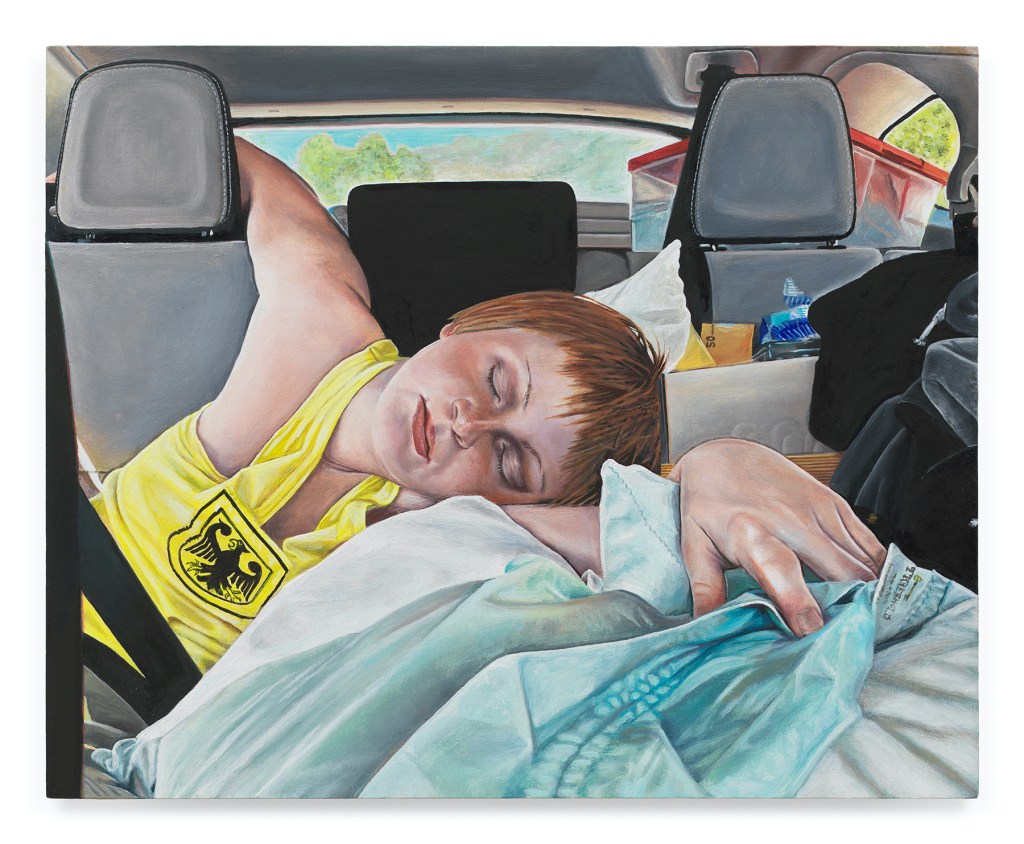Tim Hawkinson Makes the Ordinary Otherworldly


I first wrote about Tim Hawkinson’s extraordinary, often large mechanical sculptures constructed from everyday materials, such as soda cans, feathers, rubber tubing, and typewriters, in 2017. When I got a press release announcing an exhibition of paintings, I had to double-check to make sure this was the same artist. Once I figured out that the sculptor was exhibiting paintings, I knew I had to go and see Tim Hawkinson: Cabinet Pictures at Miles McEnery Gallery, a body of work that is new and unexpected, a continent of discrete domains that seems to have risen out of the ocean overnight.
My first surprise upon seeing the paintings was their scale. All highly detailed works done in oil on panel, none are larger than 13 inches high or wide. The images are sourced from the artist’s life. He recorded mundane and personal scenes on his iPhone, as in “Mom at Sutter’s Fort” (2014–21), which depicts a woman whose face we cannot see walking into a wood-planked room with a green bench. Her pose as she moves from one bare room into another, wearing a dark coat and pants, suggests that she is crossing a threshold. Hawkinson’s paintings come across as mysterious and, in this regard, share little with other photo-based painters, such as Robert Bechtle, Richard Estes, or Chuck Close, all of whom worked on a large scale.

Hawkinson’s paintings can easily pull you in. The ordinary becomes otherworldly in perplexing ways. The details and color gradations in these small pieces based on iPhone photos are astonishing, as in the gray surface of the car seats and head rests in “Hansa Yellow College Tour” (2025), which shows his college-bound daughter asleep in the back seat, her head located in the center of the painting. In “Onsala” (2022), Hawkinson depicts his daughter resting on two boulders just offshore in Sweden, asleep. With her arms folded across her chest, she reminds me of the Vikings.
Hawkinson’s love of perfected details and smooth surfaces aligns him with Northern Renaissance artists such as Hans Holbein. Like Holbein, Hawkinson does not idealize his subjects. In “Wake” (2022), a forefinger extending in from the painting’s right edge touches the that of an unshaven man lying in bed against a black background. The two fingers meeting brings to mind Michelangelo’s fresco, “The Creation of Adam,” on the ceiling of the Sistine Chapel, but in its realism the painting is closer to Holbein. In “The Creation of Adam,” God does not quite touch Adam’s finger.

It is hard to believe that Hawkinson sought out loaded images. Rather, I believe he found his resonant pictures scrolling through the innumerable ones he took and picking those that spoke to him personally. These works transcend the literal without becoming overtly symbolic; this is the tight rope he walks. There is a religious element to his work that emerges even in secular scenes, such as “Flagellation Post” (2022), which shows a painted yellow steel post wrapped in chains.
While photorealism feels like a historical period of contemporary art, mostly limited to the 1960s and ’70s, Hawkinson has transformed it into something very different. He conjures an awareness of time passing, and of his sitters’ interior lives. The paintings are not about appearances, but about depths at which the images only hint. “Dad/Plane” and “Clare/Plane” (both 2021) portray family members on flights during the height of the COVID-19 pandemic, when no vaccine was available. The awareness of mortality is palpable. That is something we don’t find in the celebrated photorealists of an earlier era.



Tim Hawkinson: Cabinet Pictures continues at Miles McEnery Gallery (520 West 21st Street, Chelsea, Manhattan) through June 21. The exhibition was organized by the gallery.





